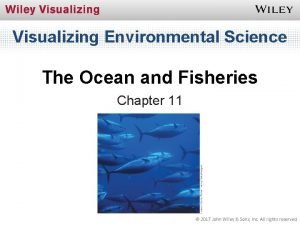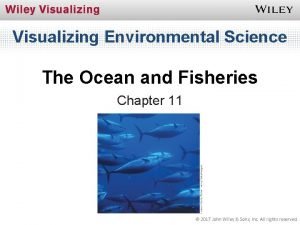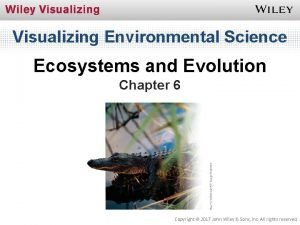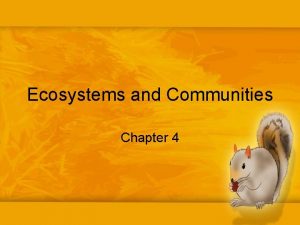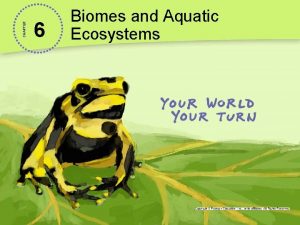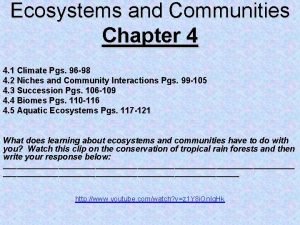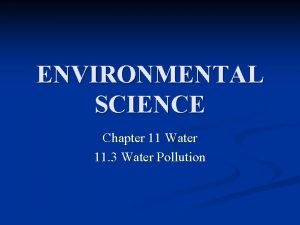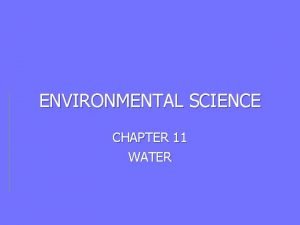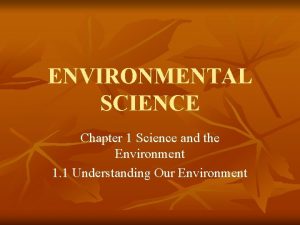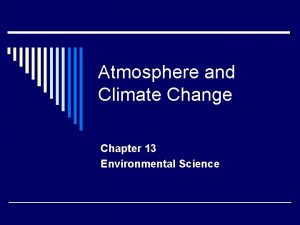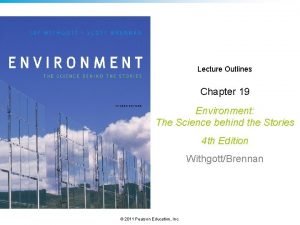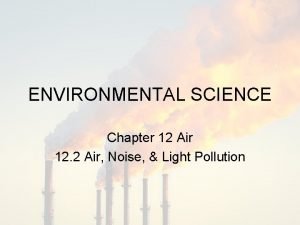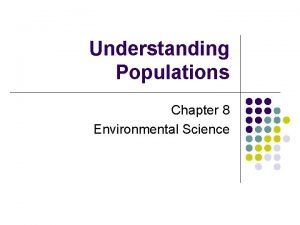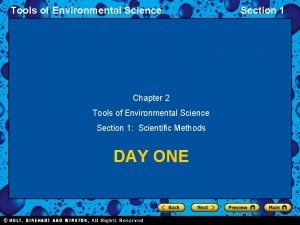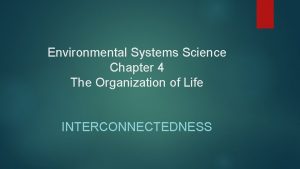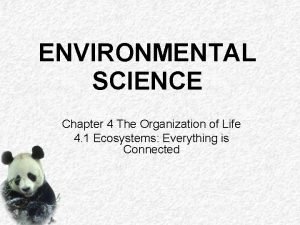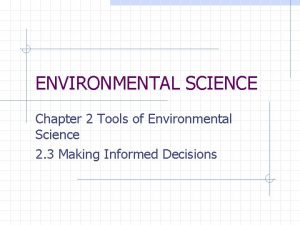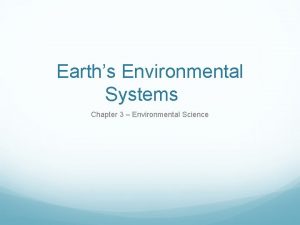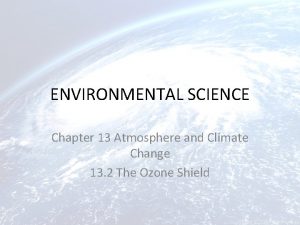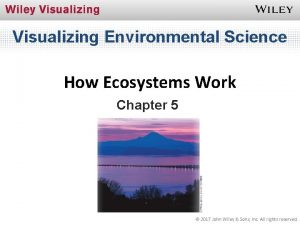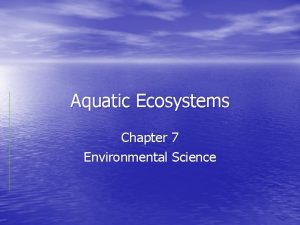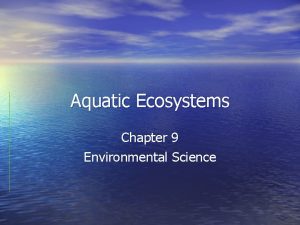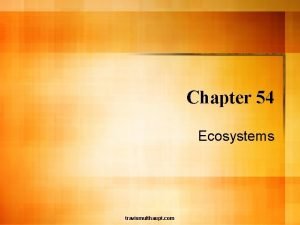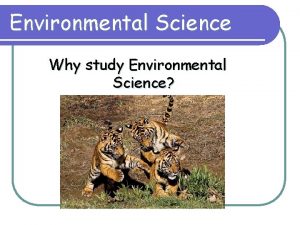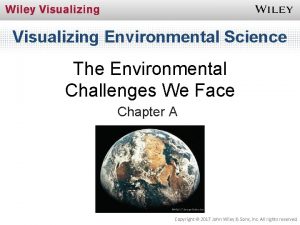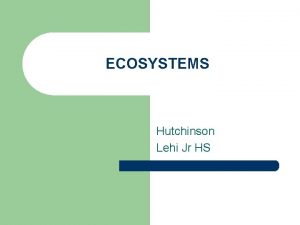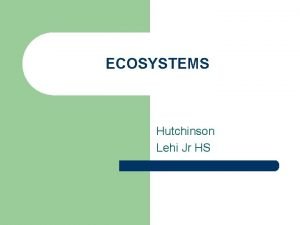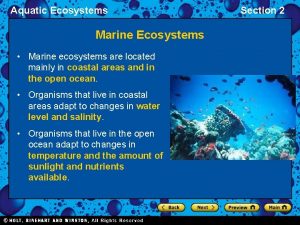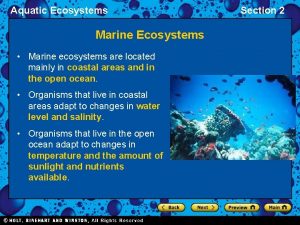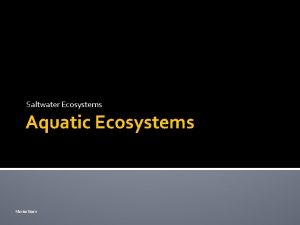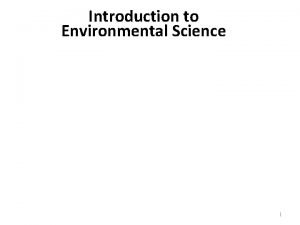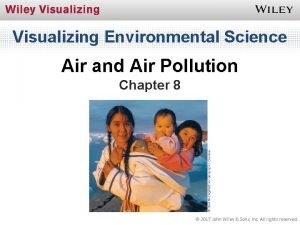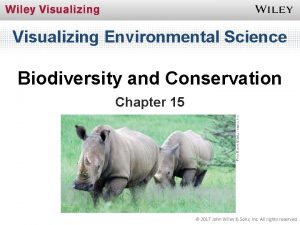Visualizing Environmental Science Ecosystems and Evolution Chapter 6




























- Slides: 28

Visualizing Environmental Science Ecosystems and Evolution Chapter 6 Copyright © 2017 John Wiley & Sons, Inc. All rights reserved.

Factors That Shape Biomes • ______—a large, relatively distinct terrestrial region with similar ______ (long-term weather pattern), soil, plants, and animals, regardless of where it occurs in the world Copyright © 2017 John Wiley & Sons, Inc. All rights reserved.

Factors That Shape Biomes • _________ and precipitation have a predominant effect on biome distribution – Temperature most important factor near poles – __________ more important in tropical and temperate regions • ________ also affects biomes – Vegetation changes with increasing elevation resembles the changes in vegetation from warmer to colder climates Copyright © 2017 John Wiley & Sons, Inc. All rights reserved.

Describing Earth’s Major Biomes • There are nine major terrestrial biomes on earth – – – – – _______ Boreal forest Temperate rain forest Temperate deciduous forest Temperate grassland Chaparral _______ Savanna Tropical rain forest Copyright © 2017 John Wiley & Sons, Inc. All rights reserved.

Arctic Tundra • Treeless biome in the far _____ that consists of boggy plains covered by lichens and mosses • Harsh, cold winters and extremely short summers and seasonal snow melting • Low primary productivity and ______ resilience • ________—layer of permanently frozen ground – Climate change causing permafrost to thaw Copyright © 2017 John Wiley & Sons, Inc. All rights reserved.

Boreal Forest/Taiga • Coniferous forests of pine, spruce, and fir, in the Northern Hemisphere, just south of tundra • Winters extremely cold and severe • _____ precipitation, 20 in/year • Soil is acidic and mineral poor • Ponds and lakes dug by _____ • Caribou, wolves, bear, _____, rodents, rabbits, lynx, birds in summer, lots of insects • Top source of industrial wood and fiber, leading to ____ of Copyright © 2017 John Wiley & Sons, Inc. All rights reserved.

Temperate Rain Forest • Coniferous forest with ____ precipitation, dense fog and cool weather • Northwest coast of North America, SE Australia, South America • Mild winters, cool summers • Slow decay, _______ soil • Hemlock, fir, cedar, spruce, epiphytes, mosses, lichens and ____ • Squirrels, wood rats, elk, mule deer, birds, amphibians and reptiles • High producer of lumber and pulpwood • ___________ old-growth Copyright © 2017 John Wiley & Sons, Inc. All rights reserved. forest is an issue

Temperate Deciduous Forest • Forest biome that occurs in temperate areas where precipitation ranges from 30– 60 in/year • ______ summers, cold winters • Topsoil rich in organic matter • Broad-leaf hardwood trees, lose leaves seasonally • Originally home to _______, wolves, and bison; now deer, bears, small mammals, birds remain • Original forests in Europe and North America mostly destroyed by ____ and urbanization • Deciduous forest biomes were the first converted to __________ use Copyright © 2017 John Wiley & Sons, Inc. All rights reserved.

Temperate Grassland • Tallgrass prairies and shortgrass prairies • Hot summers, cold winters, and less rainfall (10 – 30 in/year) than in temperate deciduous ____ biome • Soil rich in organic matter • More than _____ of tallgrass prairies were plowed for agriculture, now North America’s _____ biome Copyright © 2017 John Wiley & Sons, Inc. All rights reserved.

Chaparral • Mild, moist winters; hot, ______ summers • Small-leaved evergreen shrubs and _____ trees dominate • Lush vegetation during rainy winter season • ________ common in late summer and autumn – Many fire adapted plants that grow after a fire • Thin, unfertile soil Copyright © 2017 John Wiley & Sons, Inc. All rights reserved.

Desert • Plant growth limited by lack of ___________ • Daily temperature extremes • Less than ____ inches of rain/year • Sparse vegetation that includes cacti, yucca, and sagebrush • Animals – Typically small, mostly nocturnal – _______, arachnids, desert-adapted amphibians, many reptiles • Threatened by human encroachment and environmental damage from off-road vehicles – Soil easily _______ and less vegetation grows to support native animals Copyright © 2017 John Wiley & Sons, Inc. All rights reserved.

Savanna • Tropical _________ • Widely scattered or clumped trees • Low or intense seasonal rainfall, 34– 60 in/year, but with prolonged dry periods • Low mineral-content ____ • Large herds of herbivores such as wildebeest, antelope, giraffe, zebra, elephant • Large carnivores such as _______ and hyenas • Savanna is lost as it is converted into rangeland for _____ • Africa, North Australia, South America, West India Copyright © 2017 John Wiley & Sons, Inc. All rights reserved.

Tropical Rain Forest • Lush, species-rich forest that occurs where the climate is warm and moist ________ • Rains almost ______, 80– 180 in/year • Weathered, mineral-poor soil • High species richness and diversity – Most species live in the ____ • High rate of decomposition • In tropical dry forests precipitation is lower and more seasonal • Industrial expansion and human population growth _______ the rain forests Copyright © 2017 John Wiley & Sons, Inc. All rights reserved.

Aquatic Ecosystems • Aquatic ecology – Freshwater or _________ – Salinity, light availability, nutrient concentration, and dissolved _______ all affect location and type of species present in a body of water – Aquatic ecosystems contain three main categories of organisms • ________—phytoplankton and zooplankton – Microscopic, free floating • Nekton—fish and turtles – Larger, swimming organisms • Benthos—sponges, oysters, worms, ______, etc. – Bottom dwelling organisms, either fixed, burrowing, or walk on bottom Copyright © 2017 John Wiley & Sons, Inc. All rights reserved.

Freshwater Ecosystems • Freshwater ecosystems include – Standing-water (____ and ponds) – Flowing-water (rivers and streams) – ________ (marshes and swamps) • Occupy _____ of earth’s surface, yet play important role in hydrologic cycle Copyright © 2017 John Wiley & Sons, Inc. All rights reserved.

Freshwater Ecosystems • Standing water ecosystem – A body of fresh water surrounded by land whose water does not _____; a lake or a pond. – Human effects include unintended ___________ unnatural nutrient enrichment which can significantly affect the ecological balance of the body of water Copyright © 2017 John Wiley & Sons, Inc. All rights reserved.

Freshwater Ecosystems • Flowing water ecosystem – A freshwater ecosystem such as a river or stream in which water _______ in a current • Highly variable, as the surrounding environment changes between the river’s source and mouth – Shading by trees in some areas, sunlight in others – Groundwater infiltrate changes water temperatures locally – Types of organisms present depend on ________ of current • Adverse human impacts include ________ and dam construction Copyright © 2017 John Wiley & Sons, Inc. All rights reserved.

Freshwater Ecosystems • Freshwater wetlands • Lands that _______ fresh water covers for at least part of the year; wetlands have a characteristic soil and water-tolerant vegetation – Marshes: dominated by _________ plants – _______: dominated by woody trees or shrubs – Waterlogged soils • Anaerobic, low rate of decomposition • Rich in organic material – Productive ______ communities Copyright © 2017 John Wiley & Sons, Inc. All rights reserved.

Freshwater Ecosystems • Freshwater wetlands provide important environmental functions known as ___________ – Ecosystem services include: • Providing wildlife _______ • Flood mitigation • Serving as groundwater recharge areas • Trapping _______ from floodwaters –Wetlands are threatened by pollution, _________ and agriculture Copyright © 2017 John Wiley & Sons, Inc. All rights reserved.

Estuaries • ________ – Coastal body of water, partly surrounded by land, with access to both the _____ and fresh water from a river • Salt marshes—shallow _______ with salt-tolerant grasses in temperate areas • ________ forests—tropical equivalent of salt marshes – Provide extensive habitat/breeding grounds for fish, shellfish and birds – Prevent coastal ______ Copyright © 2017 John Wiley & Sons, Inc. All rights reserved.

Population Responses to Changing Conditions Over Time: Evolution • _________—the cumulative genetic changes in populations that occur during successive generations • ___________ proposed the mechanism of evolution (i. e. , not idea of evolution) Environment plays crucial role in which traits are inherited – Accumulation of favorable _____ leads to increased survival Copyright © 2017 John Wiley & Sons, Inc. All rights reserved.

Natural Selection • ___________ – The tendency of better-adapted individuals—those with a combination of genetic traits best suited to environmental conditions—to ______ and reproduce, increasing their proportion in the population • Evolution occurs through the ______ of natural selection – As favorable traits increase in frequency in successive generations, and as unfavorable traits _______ or disappear, the collection of characteristics of a given population changes Copyright © 2017 John Wiley & Sons, Inc. All rights reserved.

Natural Selection • Four naturally occurring phenomena guide ___________ (NS) – High reproductive capacity – _____ on population growth – Heritable variation – Differential reproductive success • Mutations provide genetic variation – ________ may be beneficial, harmful, or have no effect – Beneficial mutations will convey a survival advantage to those that possess them Copyright © 2017 John Wiley & Sons, Inc. All rights reserved.

Environmental In. Sight Evidence for Evolution • Comparative anatomy – Similarities among organisms demonstrate how they are ______ • Molecular biology – Showing relationships on a molecular level such as sharing an ______ or nucleotide base Copyright © 2017 John Wiley & Sons, Inc. All rights reserved.

Community Responses to Changing Conditions Over Time: Succession • Ecological succession • • – The process of community development over time, which involves species in one stage being _______ by different species Resident species modify the environment, making it more ________ for later species Former concept of a stable ‘climax community’ has been replaced with understanding that communities continue to ______ over time Succession is described by the changes in ______ species in a given area over tens, hundreds, or thousands of years Two types of succession: Primary and secondary Copyright © 2017 John Wiley & Sons, Inc. All rights reserved.

Primary Succession • ________ succession – The change in species composition over time in a previously __________ environment • Begins with bare ____ surfaces • Colonization with lichens first occurs, forming a pioneer community • Rock breakdown begins soil formation • Lichens mosses ____ eventually specific trees Copyright © 2017 John Wiley & Sons, Inc. All rights reserved.

Secondary Succession • __________ Succession ―Change in species composition after a ___________ in a previously inhabited area • Abandoned farmland, forest fire, clear-cut forest • _____ already present • Can take more than 100 years for secondary succession to occur • Typically crabgrass horseweed _______ hardwood trees Copyright © 2017 John Wiley & Sons, Inc. All rights reserved.

Case Study: Wildfires • Any ___________ fire that burns in grass, shrub, and forest areas • Has ecosystem impact – Frees _________ from dry organic matter – Removes plant cover and stimulates seed germination – Increases soil erosion • Fires part of natural environment – Many fire-adapted plants rely on fire for successful reproduction • Human fire prevention over the years has made wildfire destruction ________ – Allows debris to accumulate, makes fires hotter, more destructive – _______ burning is a management tool now used that reduces organic debris and decreases fire severity
 Visualizing environmental science solution manual
Visualizing environmental science solution manual Visualizing environmental science solution manual
Visualizing environmental science solution manual Visualizing environmental science (doc or html) file
Visualizing environmental science (doc or html) file Why environmental science is an interdisciplinary science
Why environmental science is an interdisciplinary science Chapter 4 ecosystems and communities
Chapter 4 ecosystems and communities Savanna biome plants
Savanna biome plants Why biomes are important
Why biomes are important Phosphorus cycle pearson education
Phosphorus cycle pearson education Chapter 42 ecosystems and energy
Chapter 42 ecosystems and energy Chapter 3 lesson 3 biomes and aquatic ecosystems
Chapter 3 lesson 3 biomes and aquatic ecosystems Chapter 55 ecosystems and restoration ecology
Chapter 55 ecosystems and restoration ecology Chapter 4 ecosystems and communities
Chapter 4 ecosystems and communities His favourite subject is
His favourite subject is Objective of water pollution
Objective of water pollution Is water that contains waste from homes or industry
Is water that contains waste from homes or industry Environmental science chapter
Environmental science chapter Environmental science chapter 13 review
Environmental science chapter 13 review Chapter 19 environmental science
Chapter 19 environmental science Environmental science chapter 2
Environmental science chapter 2 Radonrid
Radonrid Environmental science chapter 8 review answer key
Environmental science chapter 8 review answer key Environmental science chapter 2 review answers
Environmental science chapter 2 review answers The day they parachuted cats into borneo food web
The day they parachuted cats into borneo food web Environmental science chapter 4 the organization of life
Environmental science chapter 4 the organization of life Chapter 2 assessment environmental science
Chapter 2 assessment environmental science Earth's environmental systems chapter 3
Earth's environmental systems chapter 3 What are the 3 levels of biodiversity
What are the 3 levels of biodiversity Limestone ridges built by tiny animals
Limestone ridges built by tiny animals Chapter 13 environmental science
Chapter 13 environmental science
